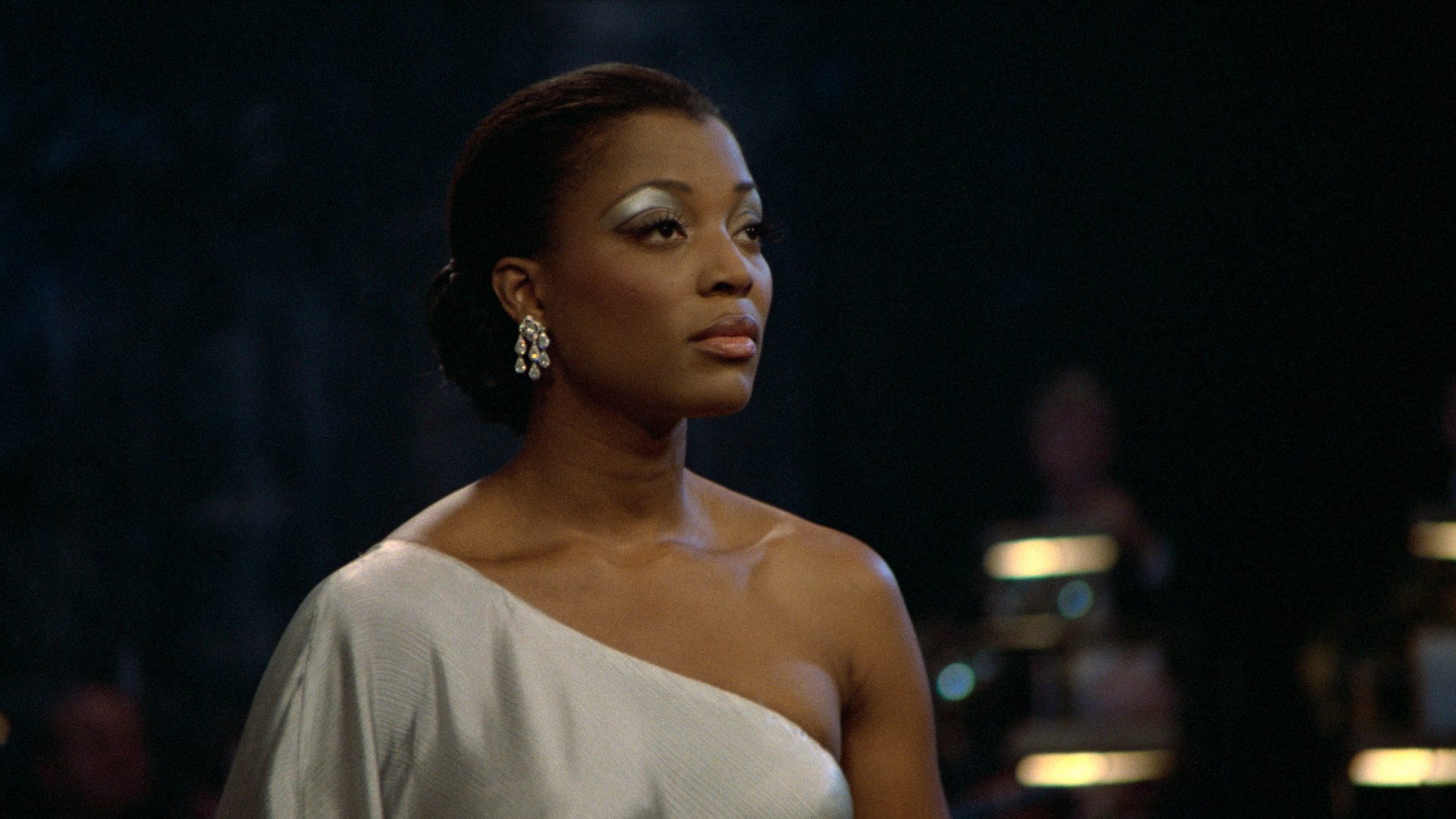Near the start of Jean-Jacques Beineix’s Diva (1981), teenage French-Vietnamese shoplifter Alba (Thuy An Luu) is spotted stealing an unlikely item: an album of opera arias. It’s not for her, she explains. She’s taken it for a friend – “a guy who’s going through his cool period”.
Beineix’s stylish thriller of obsession, artistry and motion, newly available in an impressive 4k restoration, heralded the start of a cool period in French film. Together with Luc Besson (Subway, La Femme Nikita, Léon) and Leos Carax (Les Amants du Pont-Neuf), Beineix helped to sweep away the 1970s realism that followed the golden era of nouvelle vague. In its place, they offered an era of slick pictures that would catch on not only at home but also in the English-speaking world.
Pop into any student digs during this era and you might see the international Diva one-sheet – featuring moped-riding hero Jules (Frédéric Andréi), titular soprano Cynthia Hawkins (Wilhelmenia Wiggins Fernandez) and the bald, monosyllabic hitman The Priest (Dominique Pinon) – next to posters for Besson’s The Big Blue or Beineix’s Betty Blue.
The critic Roger Ebert called Diva “a thriller that is more about how it looks than what happens in it,” but what happens in it revolves around two highly coveted secret recordings.
Jules is a postman with a passion for opera in general and the performances of Hawkins in particular. Hawkins has never allowed anyone to record her singing, and this is a red rag to the bullish postie, who uses covert methods to obtain a high-quality tape of the diva performing the now-ubiquitous aria from Alfredo Catalani’s La Wally. This is noted by two Taiwanese gentlemen who turn out to be very keen to lay their hands on Jules’s work.
Jules soon finds himself in possession of another tape: the testimony of prostitute Nadia (Chantal Deruaz), in which she reveals that the local chief of police Jean Saporta (Jacques Fabbri) is among the biggest drug dealers in Paris. Nadia just has time to secrete her confession in Jules’s mail bag before she is murdered by Saporta’s henchmen.
When they figure out what Nadia has done, they set off in pursuit of Jules, who has also come to the attention of a pair of policemen who understand that the tape implicates a gangster but are unaware that the person in question is their boss.
What follows includes a daring chase sequence which speeds from the Rue de Rivoli’s arcades down into the Paris Métro, across its tracks and back up to the Opera. Ebert claimed in 1981 that the sequence “deserves ranking with all-time classics like Bullitt and The French Connection”.
Ebert was one of the film’s most enthusiastic supporters. On release, he called Diva “a brilliant film, a visual extravaganza… pure exhilaration,” and when reviewing a new print in 2008 he hailed it as “a dazzling kaleidoscope of sex, action and startling images”.
Diva, adapted from a 1979 novel by Delacorta (a pseudonym for the writer Daniel Odier, then an associate of William Burroughs and now a tantric sex guru) – certainly ladles on the style; remarkably so given that it was made for the equivalent of what would be £2.6million today. Its mysterious characters operate in huge warehouse-style spaces, soundtracked by Vladimir Cosma’s lilting score. There is a lighthouse, a couple of vintage Citroëns, a beautiful robe of silver silk and a kinetic sculpture that mimics the motion of waves, the property of Alba’s much-older, bohemian protector Gorodish (played by Richard Bohringer; the pair appear in five increasingly questionable sequel novels – Nana, Luna, Lola, Vida and Alba).
This kind of stuff Diva led to accusations of emptiness. Indeed, seven years after its premiere, Alex Cox introduced it on his BBC2 film strand Moviedrome, by calling it “big on style and short on substance… the kind of film that gets called ‘scintillating’, or ‘fabulous, frothy fun’. It doesn’t, however, have any real passion, nor any acting worthy of note.”
Today, the Repo Man director admits he “couldn’t stand it”, but says: “The thing I loved about Diva is the scene where everything’s been designed around a packet of cigarettes – the colour of the walls, the set decoration, the costumes, everything exists to complement a packet of Gitanes. It’s a wonderful piece of art direction, and so I made a point of mentioning [production designer] Hilton McConnico.”
Cox was not alone in his scepticism. Even Diva’s producers, Claudie Ossard (later to produce Jean-Pierre Jeunet and Marc Caro’s Delicatessen and Amélie) and married couple Irène and Serge Silberman (the latter a veteran of Luis Buñuel’s fims), weren’t taken with it at first.
“They hated my film,” explained Beineix. “They hated the title; they didn’t think you could sell a crime movie called Diva. And they didn’t like my approach to the material. By the end of the shoot, I think they’d have been quite happy had we never crossed paths.”
One particular incident, involving Pinon’s menacing character, would have made the money men blanch. The actor remembered: “Jean-Jacques got the idea for the look of my character when he was riding the Tube in London and he saw this guy, a skinhead in all this punk getup…
“So there we are, shooting near the Champs-Élysées, a couple of days after Eta had bombed Paris, and there’s lots of security about. Now the crew toilets were a long way from the set… So after I used them, I was walking back to the location when a couple of police officers stopped me. I was in my punk get-up. And not only that, but I had a dagger in my pocket. It took a lot of persuading to leave them convinced that I didn’t pose a threat to society!”
The producers may have felt vindicated by early reviews in France. “The critics didn’t like the film at all and they bashed it,” said Beineix. “Specifically the critics of the New Wave. They said there was too much style and no substance, which is not true at all.”
There is clearly more to Diva than meets (and pleases) the eye. For the director – a movie obsessive from an early age who graduated to working for French greats like Jacques Becker, René Clément and Claude Berri – it was “a movie about technology, and technology versus artists. If I had to keep one phrase from the film, it’s when the diva says, ‘It is up to business to adapt to art, and not to art to adapt to business’. I know it’s very naive but I still believe in it.”
Suggested Reading


The new film capital of the world is… Oslo
Ultimately, the artists won. In the US and Canada, Diva became a cult hit on the midnight movie circuits. In the UK, its distribution rights were picked up by Stephen Woolley and Nik Powell’s Palace Pictures, who paid well over the odds, convinced it was the most important French film debut since Godard’s A Bout De Souffle.
To weaken consumer resistance, they hired hot young designers like Mike Leedham to cook up a non-traditional ad campaign. The fruits of this included a second very cool poster for the movie, featuring a motorcycle helmet and Pinon’s hitman in a pair of shades. Copies were regularly pilfered from advertising hoardings and repurposed as student wall hangings.
A big hit in the West End, Diva would later enjoy huge success on video, thanks in part to Woolley’s decision to release a dubbed cut. “Anyone seeing the English version might have noticed a slightly different style,” he said. “We couldn’t get the dubbed version to fit on one video so we had to run it a little faster to squeeze the whole thing in!”
The international acclaim helped Diva win four Césars – the French Oscars – including best debut for Beineix, best music for Cosma and a nod for cinematographer Philippe Rousselot. The film is now recognised as the first in a wave that the critic Raphaël Bassan described with the phrase cinéma du look. “It was the look itself, rather than the content, that defined the films, and sometimes the plots seemed almost designed to create photographic opportunities,” wrote Ebert in 2008.
The movement’s success would not last, however. By the late 1990s, eing considered passé by the mid-1990s. Yet in another sense it has never gone away. Films that look like commercials, advertisements that look like mini-movies – the worst of it is still very much with us.
Of the cinéma du look directors, Carax did not make a feature film between 1999 and 2012, and though Besson had an international hit with the Marmite blockbuster The Fifth Element (1997), subsequent movies have delivered diminishing artistic returns.
The Moon In The Gutter, Beineix’s over-stylised follow-up to Diva, stiffed, and though his biggest hit, Betty Blue (known in France as 37°2 Le Matin) suggested a renaissance, it is now mostly remembered for its incredibly sweaty opening minutes. Beineix was tempted by Hollywood, making 40 transatlantic trips in a few short years, but it didn’t take.
“I’ve become disillusioned,” he told the LA Times in 1994. “After Diva, I was almost ready to emigrate (to the United States) because I had the feeling that Europe was old-fashioned and decaying. But then I discovered that Hollywood was decaying, too. Not because of the people… but because of the mentality, the greediness.
“This business is really a business, and artists have become some kind of strange, difficult beings. I thought that Hollywood was the place you could make dreams come true, where adventure was possible. But it is just bureaucratic, and it’s less and less involved in creation and creativity.” The director died in 2022.
Yet as this new restoration reveals, Diva is more than just a boundary-pushing exercise, more than just style over substance. It is a highly entertaining film made by creators determined to remind us that cinema can sweep people off their feet.
An apple-cart upsetter then, but one so satisfying that it will leave you reaching for a cigarette afterwards. Gitanes, anyone?
Diva is released on Blu-Ray and 4K UHD as part of StudioCanal’s Vintage World Cinema collection.
Film writer Richard Luck’s Substack blog is called As Luck Would Have It










